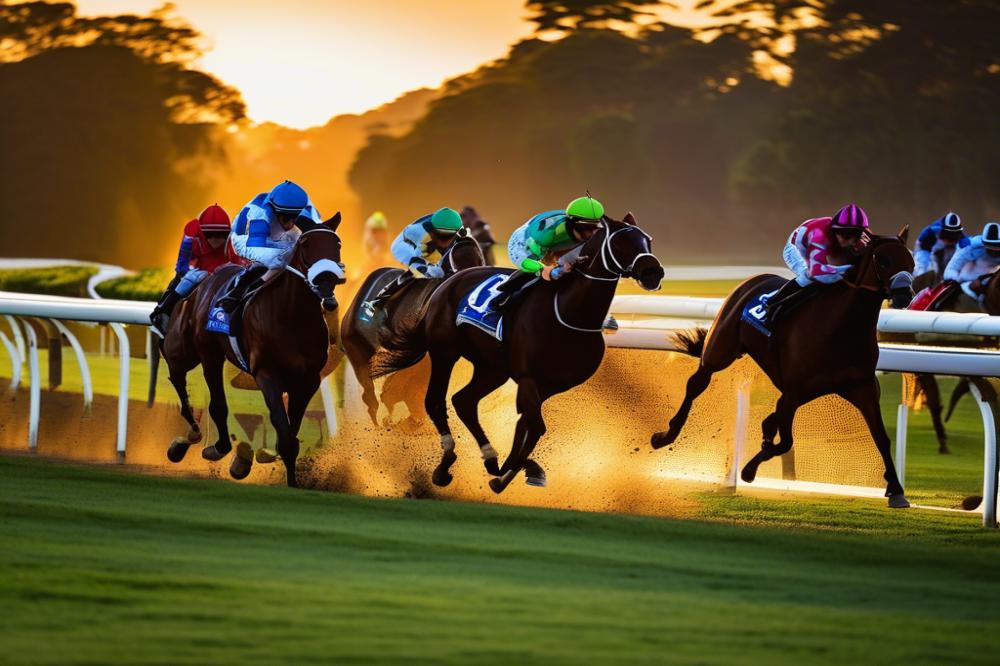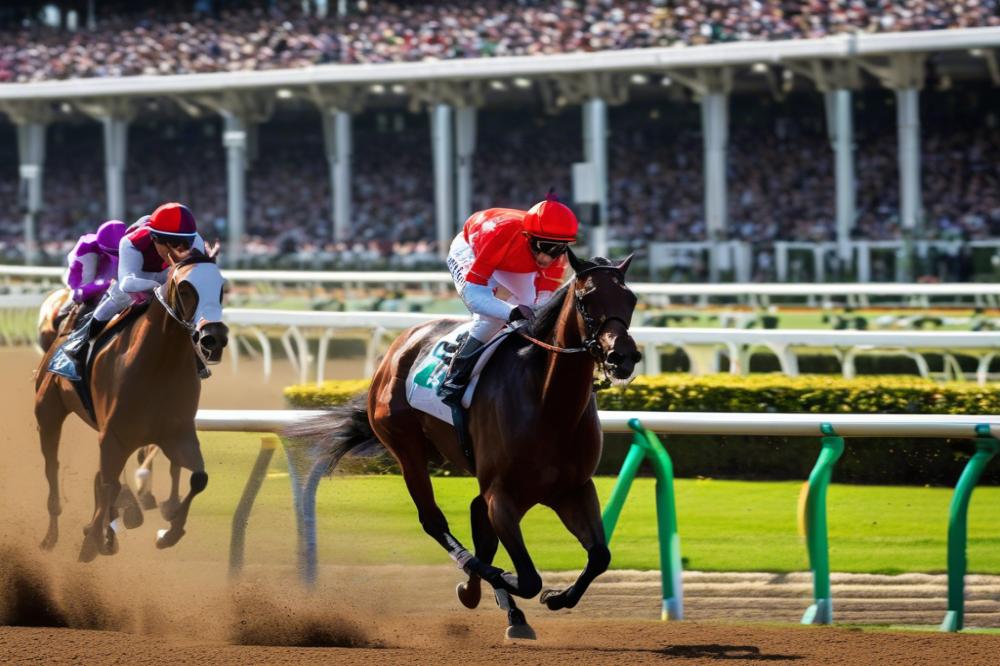Introduction
Thoroughbred racing is a prominent sport that captivates audiences around the globe. It showcases the speed and agility of one of the world’s most elegant horse breeds. Races involve a series of competitions, where jockeys test their skills against each other, all while guiding their horses to victory. This exhilarating environment places a strong emphasis on skill and technique, making it critical for riders to master their craft.
In equestrian sports, this type of racing holds significant importance. Success is not merely measured by winning races but also by the bond formed between horse and rider. Mastering riding techniques can be the difference between leading the pack and finishing far behind. Riders must understand their mounts, especially since Thoroughbreds possess a spirited nature. Knowing how to communicate effectively with these animals can lead to strong performances.
Moreover, every moment in competitive riding matters. From the pre-race warm-up to the final dash to the finish line, a rider’s skills must shine through. Riders should be prepared to make quick decisions, adjusting their strategies as the race unfolds. Each race is unique, presenting its own challenges that require focus and determination.
The art of riding involves more than just maintaining balance. It demands strength, coordination, and a keen awareness of the horse’s movements. With so much at stake, focusing on these techniques is vital. Every rider has the potential for greatness; however, commitment to continuous learning and practice is essential for achieving success.
Understanding Thoroughbreds

Thoroughbreds are a distinct breed, celebrated for their remarkable qualities in racing. They typically possess a lean, athletic build, which contributes to their agility and speed. Long legs allow for impressive strides. A deep chest enhances lung capacity, enabling them to gather more oxygen during intense races. This anatomical design plays a crucial role in their overall performance.
Behaviorally, Thoroughbreds can demonstrate spirited personality traits. Many can be high-strung and sensitive to their surroundings. It is essential for riders to establish a bond with their horse. Trust can lead to improved cooperation during competitions. Confident handling from the rider fosters a calmer demeanor in these horses.
Eager to perform, Thoroughbreds often exhibit a strong competitive spirit. That drive can push them to run faster when they sense the competition nearby. Communication is key. Riders must learn to read their horse’s body language to understand when they are ready to give their best effort. A well-timed cue can make all the difference in a race.
When considering physical attributes, Thoroughbreds have a sleek coat that often shines brightly. Grooming is a vital part of their care. A clean, well-groomed horse not only looks great but can also feel more comfortable, leading to confident performance. Training regimens should focus on building strength while avoiding strain that may cause injury.
Nutrition also plays a pivotal role in their racing success. Optimal diets keep them energetic and healthy. Riders must know how to fuel their athletes properly. Feeding schedules and choices can affect stamina, focus, and overall well-being. Relying on high-quality feed and maintaining hydration is crucial.
In summary, Thoroughbreds bring a blend of physical prowess and strong personality that can affect racing outcomes. Understanding these unique aspects is vital for any rider aiming to excel in competitive settings. Familiarity with their traits offers insight into maximizing both performance and partnership on the track.
race training Essentials

race training for Thoroughbreds involves various critical components that help prepare these magnificent animals for competition. A horse’s fitness plays a key role in its racing capability. Fitness regimens must be structured and consistent. Each horse may require a different approach tailored to its individual needs.
Conditioning exercises form the heart of training routines. These practices help build stamina and strengthen muscles. Activities can include long gallops, interval sprints, and hill work. Each type of exercise contributes to overall performance on race day.
Nutrition plays a vital role in not only a horse’s health but also its racing success. A balanced diet filled with high-quality forage, grains, and supplements is crucial. Specific nutrients help maintain energy levels and muscle function. Owners should consider consulting a veterinarian or nutritionist to develop the best feeding plan.
Fitness Regimens
Regular workouts help improve a horse’s endurance. Many trainers adopt a mix of long-distance runs and shorter, intense sessions. This variety keeps the horses mentally engaged while also building physical capabilities. Monitoring the horse’s heart rate during training can provide useful insights into its fitness.
Conditioning Exercises
Specific exercises help to prepare horses for the rigors of racing. Hill training enhances strength and cardiovascular fitness. It also helps horses develop powerful hindquarters, essential for sprinting. On a flat track, interval training pushes the horses to improve their speed and stamina.
The Role of Nutrition
A well-rounded diet is indispensable in race training. Fresh hay and grains supply energy and nutrients vital for recovery. Specialized supplements may be necessary for horses that require extra support for joints or muscles. This careful attention to diet can make a significant difference in performance level.
Jockey Techniques for Success

Riding a racehorse like a Thoroughbred requires skill and practice. Balance plays a crucial role in maintaining stability during the ride. A jockey must position their body in a way that allows them to stay centered over the horse’s back. When the horse accelerates, shifting weight correctly can help improve speed.
Grip is another important element. A jockey needs to feel secure in the saddle while also being able to respond quickly to the horse’s movements. The legs should wrap around the horse firmly but comfortably. This grip allows for better control, especially when making critical decisions in a race.
Body positioning greatly influences performance. Lowering the torso toward the horse’s neck can reduce wind resistance. This positioning aids in maximizing speed while keeping the horse balanced. Flexibility in the knees and hips also allows for easier adjustments. When the horse turns, a jockey must lean into the turn, helping the horse navigate the curve effectively.
Understanding horse behavior is essential. Each horse has a unique personality, and recognizing these traits helps create a bond. This connection enables the jockey to read the horse’s mood and energy levels. Communication comes into play, as subtle cues can guide the horse’s actions. A gentle squeeze of the legs might signal the horse to speed up. Conversely, relaxing the grip can encourage the horse to settle down.
Anticipating a horse’s responses is key to jockeying success. Some horses respond better to certain techniques than others. Feeling the rhythm of the horse beneath can make a notable difference. Experienced jockeys can often predict the horse’s movements, reducing the chance of mistakes during a race.
Building trust with the horse is necessary. Developing this trust comes from consistent training and care. A jockey must show confidence to the horse, as they can sense hesitation. Each race is an opportunity to deepen that connection and improve performance. Training sessions can also serve to strengthen this bond, making both horse and rider more effective on race day.
Track Preparation and Strategy
Preparing for a race begins long before you mount your horse. Understanding the track is essential. Each surface presents its own set of challenges. Observing the condition of the track can aid in developing a winning strategy. Rain can make the ground muddy and slippery. On the other hand, a dry track might be very hard and fast.
Take time to assess how the weather influences the surface. If the track is slick, a softer riding technique may be needed. Adjusting your posture can help maintain balance. Shifting your weight back slightly might also be beneficial. This helps your horse maintain better footing.
Strategies change with each race. Some tracks favor strong, powerful horses, while others might support quick, agile ones. Knowing your horse’s strengths is vital. If the weather is warm, maintaining hydration and avoiding overheating is necessary. Keep track of how many laps the horse can comfortably run.
Learning to read the track is a skill. Look for areas that show wear and patterns where other horses might struggle. Using these insights can help you decide when to push forward or hold back. Make a plan for sharp turns or downhill segments. Adjusting your speed at these points can make a difference.
Race tactics are affected by all of this. If the ground is loose, a steady pace can help. In more stable conditions, a burst of speed closer to the finish can be effective. Observe the competitors as well. Watching how they approach the track can inform your own strategy.
Every race offers new experiences. Each track has its quirks that you must learn. Practice helps you feel comfortable navigating various conditions. Spend time familiarizing yourself with the environment before the race. Knowledge of the track leads to better decisions during intense moments.
Stamina Management During Races
Managing the stamina of a Thoroughbred during a race is crucial to achieving a good position. Pacing is one strategy that cannot be overlooked. Riders must find the right speed early on. This helps conserve energy for later moments. Starting too quickly can lead to exhaustion before the finish line.
Timing is equally important. Knowing when to push for speed can make all the difference. As the race progresses, watch for cues from the horse. Signs of fatigue might indicate that it is time to hold back a little. Conversely, if the animal feels strong, it may be the perfect opportunity to accelerate.
Situational awareness also plays a big role. Keep an eye on other competitors. Observing their speed can help inform your own pacing decisions. If a rival makes a move, being ready to respond is vital. Responding too late can cost distance.
Getting to know your horse is essential for effective stamina management. Each Thoroughbred has its own rhythm and preferred speed. Developing a bond with the horse allows for better communication. Trust and familiarity can lead to making the right choices during high-pressure moments.
Overall, the approach to a race should be flexible. Races can change unexpectedly. Therefore, adapting to the unfolding situation is key. Sometimes, holding back while others rush ahead is wise. Timing your efforts can be a game-changer in the last stretch.
Riders should also focus on maintaining a good posture. A balanced seat helps minimize undue strain on the horse. This aids in efficiency throughout the race. A relaxed rider allows the horse to manage energy better.
Consider the surface of the track as well. Different conditions can affect stamina differently. Softer tracks may require more effort to maintain speed. Understanding these elements can influence decisions on pacing and pushing.
Horse Riding Tips for Competitive Settings
Riding a Thoroughbred in competitive situations is a thrilling experience. Preparation plays an important role in how you and your horse perform. Start with a solid warm-up routine before the race. It helps the horse loosen up and get in the zone. A few gentle laps around the paddock will work nicely. Include stretching exercises to promote flexibility. Allow them to trot and canter lightly. This activity gets the blood flowing and the muscles warmed.
Matter of fact, using groundwork can also be beneficial. Spend some time with your horse on the ground. This approach reinforces trust and communication. A calm horse is often a more focused competitor. Check their tack before getting on. Proper equipment is key to both comfort and safety during the ride.
During the race, maintain a balanced position in the saddle. Keep your hands steady and your legs relaxed. Think about riding with your body, not just your hands. The rhythm of the horse is crucial. Listen to their movements and adjust your grip accordingly. Focus on relaxing your lower body. Tension can disturb the horse’s stride.
Post-race care is just as essential. Start cooling them down right after crossing the finish line. Walk them for at least ten to fifteen minutes. This helps lower their heart rate. Offer water gradually, as some horses can be sensitive after intense exercise. Once settled, check for any signs of injury or fatigue. Groom them gently, as this can be soothing.
Pay attention to their breathing and demeanor. These signs can guide you on how they feel. Feed them a light snack once they are calm. Remember, keeping them hydrated is important. Be aware of a horse’s needs during recovery. Each Thoroughbred is different, and knowing your horse enhances performance.
Final Thoughts on Riding Thoroughbreds
In summary, riding a Thoroughbred in competitive settings involves numerous crucial elements. Success depends on both the rider’s skill and the horse’s training. Mastering jockey techniques can significantly enhance performance. Building a strong partnership with your horse is essential. Trust and communication between rider and Thoroughbred can make all the difference on race day.
Effective race training is another key component. Focus on conditioning, nutrition, and mental preparedness. Each of these aspects contributes to a horse’s overall readiness. Every ride is an opportunity to learn and adapt. Reflecting on various experiences helps you grow as a rider. Knowledge gained from successes and setbacks alike can inform future decisions.
Riders must remain open to new strategies and ideas. The racing world is constantly evolving, and staying up-to-date can offer advantages. Seek input from experienced riders and trainers. Their insights may provide valuable perspectives. Always remember that every race presents a chance to refine your skills. Embrace the challenges that come with competitive racing and enjoy the journey.
Finally, forging a genuine connection with your Thoroughbred is vital. Mutual respect and understanding foster greater performance as a team. The path to success in racing is not always straightforward. Stay committed to continuous learning. With dedication and passion, you can create a rewarding experience for both you and your horse.



